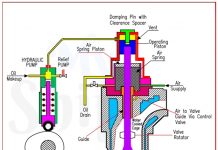
Q The direct on line start of squirrel cage motor is used for most electrical drives on A.C powered ships.
Describe with sketches as necessary one method of overcoming each of the following Problems:
a) High starting current
b) Low starting torque
Q With reference to a 3 speed A.C. cage motor driven cargo winch:
a) Draw the circuit diagram for the pole change motor.
b) Describe how speed change & braking are achieved.
Q Compare methods of obtaining speed regulation of 3-phase induction motor usually used in the tankers by means of:
a) Rotor resistance
b) Cascade system
c) Pole-changing
Give examples where each system may be employed with advantage.
Q Differentiate between squirrel cage and wound rotor motors, of the three phase a.c. induction type, in respect of the following:
a) Rotor construction
b) Toque characteristics
c) Speed variation
Q Explain the effect of reduced voltage on standard squirrel cage motors with respect to each of the following:
a) Burn out
b) Starting current
c) Starting torque
d) Speed
Q Direct on line starting for large induction motors such as those for bow thrust units, may not be viable.
a) State the reasons for this.
b) Sketch a starting system that may be used for such types of motors.
c) Describe the starting method sketched in (a, b).
Q What is soft starting of an Induction motor? Describe with the help of circuit using thyristors used for soft starting.
Discuss its advantages & disadvantages?
Q With reference to squirrel cage induction electric motors:
a) Describe the construction of such a motor.
b) Sketch the torque against speed curve of such a motor.
c) Describe the method employed by a retro-fitted device used to improve the part load performance of an induction motor.
Q With reference to squirrel cage induction electric motors:
a) Describe the construction of such type of motor.
b) Sketch the torque against speed curve of such types of motor.
c) Describe a method employed by a retro-fitted device used to enhance the part load performance of an induction motor.
Q Sketch & describe the method of speed control of synchronous motors by variable frequency. State the advantages of this method over the other methods of speed control?
Q Explain the matching of an induction electric motor to a pump required for main circulating duty, with the help of pump characteristic & torque/ship diagrams.
Q a) Sketch a circuit diagram of a push button direct on line contactor starter for a 3 phase incorporating overload & short circuit protection.
b) Indicate, on a sketch of the typical characteristic curves of current & torque against Speed, disadvantages of a direct on line start squirrel cage induction motor.
Q a) List the factors that determine the starting torque of the three-phase induction motor. How does this torque normally compared with the value of the rated torque?
b) The low-voltage release of an a.c. motor-starter consists of a solenoid into which an iron plunger is drawn against a spring. The resistance of solenoid is 35 ohm. When connected to a 220 V, 50 Hz, a.c. supply the current taken is at first 2 A, & when the plunger is drawn into the “full-in” position the current falls to 0.7 A. Calculate the inductance of the solenoid for both positions of the plunger, & the maximum value of flux-linkages in weber-turns for the “full-in” position of the plunger.
Q a) List the factors that determine the starting torque of the three-phase induction motor. How does this torque generally compare with the value of the rated torque?
b) What is back e.m.f? Derive the relation for the back e.m.f & the supplied voltage in terms of the armature resistance.
c) A 3-phase induction motor is will for four poles and is supplied from a 50 Hz system Calculate:
i. the synchronous speed
ii. the speed of the rotor when the slip is 4 per cent
iii. the rotor frequency when the speed of the rotor is 600 r/min
Q a) Explain the working principle of a 3-phase induction motor. What are the various types of rotors?
b) An 18.65 kW, 6-pole, 50 Hz, 3-ɸ slip ring induction motor runs at 960 rpm on full load with a rotor current per phase of 35 A. Allowing 1 kW for the mechanical losses, find the resistance/phase of the 3 phase rotor winding.
Q a) Show how the power that is transferred across the air gap of the 3-phase induction motor is represented. Explain the terms. What portion of this is useful power?
b) A 440 V load of the 400 KW at 0.8 (lagging) power factor is jointly supplied by two alternators A & B. The kW load on A is 150 kW & the kVAr load on B is 150 kVAr (lagging). Determine the kW load on B, the kWAr load on A the power factor of operation on each machine & the current loading of each machine.
Q a) Sketch a graph of starting current & torque against the speed of rotation for a single cage motor.
b) A 230 V motor, which generally develops 10 kW at 1000 rev/min with an efficiency of 85 %, is to be used as a generator. The armature resistance is 0.15 ohm & the shunt field resistance is 220 ohm. If it is driven at 1080 rev/min & the field current is adjusted to 1.1 A, by means of the shunt regulator, what output in kW could be expected as the generator, if the armature copper loss was kept down to that when running as motor?
Q a) What is slip? What are the factors on which the torque or an induction motor depends?
b) A 220-V, 3-ɸ, 4-pole, 50 Hz, Y-connected induction motor is rated at 3.73 kW. The equivalent circuit parameters are:
R1=0.45 , X1=0.8 , R2=0.4 , Bo=-1/30 mho
The stator core loss is 50 W & rotational loss is 150 W. For a slip of 0.04, find:
i. Input current
ii. p.f.
iii. Air-gap power
iv. Mechanical power
v. Electro-magnetic torque
vi. Output power and
vii. Efficiency
Q a) Why is a synchronous motor not self-starting? What are the various ways in which it can be started?
b) A 500V, single phase synchronous motor gives a net output mechanical power of 7.46 kW & operates at 0.9 p.f (lagging). Its effective resistance is 0.8 Ω. If the iron & friction losses are 500 W & excitation losses are 800 W, calculate the armature current & the commercial efficiency.
Q a) What is slip? What are the factors on which the torque of a induction motor depends?
b) Calculate the pitch factors Kp for a winding having 24 stator slots, 4 poles, when the coil span is 1 to 6.
Q a) Explain how rotating magnetic field is produced in 3-phase winding with three phase supply.
b) A 4-pole, 3-phase induction motor operates from a supply whose frequency is 50 Hz. Calculate:
i. Speed at which the magnetic field of stator is rotating.
ii. Speed of the rotor when the slip is 0.04
iii. The frequency of the rotor current when the slip is 0.03
Q a) What are the factors which determine the synchronous speed of a motor?
b) The star-connected rotor of an induction motor has a stand-still resistance of 4.5 Ω/phase & a resistance of 0.5Ω /phase. The motor has an induced e.m.f of 50 V between the slip-rings at standstill on open circuit when connected to its normal supply voltage. Find the current in each phase & the power factor at start when the slip-ring is short circuited.



